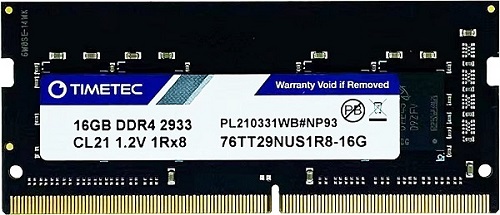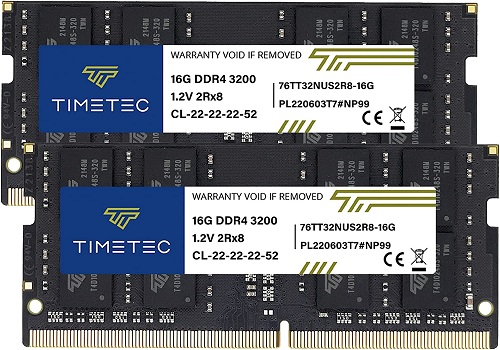To boost the performance of a system, the specification of hardware components such as RAM matters in a lot of ways. Users know several factors like capacity, clock speed, DDR generation, etc. Apart from these, several other factors are unknown to a large portion of consumers. Memory rank is one such factor that needs enough attention.
In simple terms, the memory ranks are referred to the several numbers of memory (DRAM) chips, installed inside a memory module. Every rank offers storage and retrieval of data by using these memory chips. The system’s overall data-handling process can be improved with different configurations. To understand the memory ranks and the types of RAM based on different configurations, this article will help you walk through each detail.
Outline
ToggleMemory Ranks
Several DRAM chips are stacked together in every RAM chip. This arrangement of stacked chips is called a rank which takes an integral part in reading and writing the data. The JEDEC standards group coined the term rank. These hands are placed on either one or both sides of the RAM’s memory block. The overall width of rank goes up to 72 bits where 64 bits is the default while extra 8 bits are added as a correctional code.
Upon a closer inspection of the memory stick, users might have noticed a combination of alphabets and numbers in the following format: 1Rx8 or 2Rx8. This combination of numbers and alphabets helps in undertaking the type of RAM. Depending on the rank configuration, RAMs are available in mainly two types: Single rank RAM and Dual rank RAM. Both types of rank RAMs are explained further in detail.
1. Single Rank RAM
The Single Rank RAM, as the name suggests, consists of a single set of memory chips dedicated to reading and writing processes. In appearance, the user can actually see the memory chips mounted on one side of the RAM unit. These memory chips have a minimum capacity of 4 bits and can be placed parallelly. The overall output can be tuned to 64 bits with 8 bits extra for the code correction process.
The single-rank configuration gives a single chip an excellent reading and writing speed, compared to the dual-rank configuration. It archives this fate by dedicating a whole module to the required process at a given time. The Single-rank RAMs are easily available in the configurations like 1Rx8, 1Rx16, etc. This configuration of rank certainly has its own advantages and disadvantages which are discussed below:
Advantages
- Single Rank RAM offers faster processing of data as the memory controller goes through only one rank
- Due to the less number of memory chips used in Single Rank RAMs, it emits only a minimal amount of heat
- Single Rank RAMs are given preference for the overclocked systems
- These units are priced lower than the Dual Rank memories
Disadvantages
- It has a lower memory density compared to the Dual Rank RAMs
- This configuration is not suitable for handling multiple data handling process
2. Dual Rank RAM
The Dual Rank RAMs have two ranks/sets of memory chips which handle all the data reading and writing processes. The data handling process is divided between these two ranks, depending on the priority. The first rank usually has all the frequently accessed data while the second rank consists of occasionally accessed data. In the physical appearance, users can notice memory chips on both sides of the RAM
Dual Rank memories are used for high-end systems where multitasking and high performance are prioritized. The optimization of dual rank units improves the overall data handling process. When one rank is under the process, the second rank is kept ready for the next process via a fresh cycle. These units thereby deliver lag-free and faster data retrieval. It is
Similar to Single Rank memory, Dual Rank memory also comes with its advantages and disadvantages.
Advantages
- Dual Rank memories offer better handling of multiple data files by adding alternative layers for the process
- It has a better memory density compared to the Single Rank units and hence offers more capacity
- This memory offers a width of 128 bits, compare dot the 64 bits of Single Rank memory
- In the benchmark testing, it offers a 3 to 6% improvement in speed compared to the speed of Single Rank RAM
Disadvantages
- These units produce more heat due to the presence of multiple memory chips
- They are priced higher than the Single Rank RAMs
Difference Between Single and Dual Rank RAMs
We have already gone through the detailed explanation of both types of Ranks in Rams. The difference between these Ranks sometimes becomes a deal-breaker for many users. Learning about these differences between several parameters helps the user in selecting the ideal option. To ease this process, we have differentiated both Ranks in RAM below, depending on multiple governing parameters.
1. Primary Use
Both types of Rank memories serve a specific application due to their performance delivery. Single Rank units are ideal options for systems used for general computing. These memories easily handle tasks like documentation, internet surfing, etc. These units are also popularly used in database warehouses with small-cake server networks. When the system needs a boost in performance, the Dual Rank memory is preferred. It is used for applications where heavy computing is involved. These memories are ideal options for gaming, industrial data analysis, simulations, 3D modeling, etc.
2. Compatibility
Compatibility is one of the most crucial factors of both Single and Dual Rank RAMs. it includes compatibility with each other as well as with the system components. Dual Rank memories get the upper hand since they are compatible with most of the new systems. It also shows compatibility with the Single Rank unit, to form a combination of memories. This combination is used for very heavy computational applications. Single Rank units are also compatible with almost every system, depending on their configuration.
3. RAM Technology
The RAM technology refers to the Rank memory compatibility with the various generations of RAM. Users will find a good number of RAMs with the Dual Rank configurations. Most DDR4 generation RAMs use multiple Rank modules for enhanced computing. The reason behind this compatibility with new technologies is simple: multiple-chip construction. It helps in dedicating a memory chip for a separate computing process since it has its own storage. Some brands also offer Single Rank modules (8 to 16 GB) in the DDR4 generation. Both Rank memories are suitable with DDR3, DDR4, DDR5, and even LPDDR5 technologies.
4. RAM Size
The size of RAM is another integral factor that plays an important role in its performance delivery. Both these memories are available in several capacity options to fulfill the system’s demand. As explained earlier, the memory density of Dual Rank memory is more than that of Single Rank memory. Therefore, Dual Rank memories comfortably offer almost twice a Single Rank unit capacity. Single Rank RAM is available in 8 to 16 GB variants. Dual Rank RAMs are easily available up to 32 GB configuration. Anything beyond that needs a combined setup of these RAMs.
5. Performance
The performance parameter is checked for both units by testing them under several conditions. With the singular chip construction of Single Rank memory, it is observed that the system’s CPU will show more usage. The CPU usage lowers in Dual Rank memories, but the process allocation in two cycles makes handling of data slow for initial stages. Even with these conditions, the performance of Dual Rank memories goes beyond that of Single Rank due to Rank interleaving. This performance difference can be noticed when the system is under intensive loading conditions. The heat generation is more in Dual Ranks units than the Single Rank memories.
Which is Better Amongst Single and Dual Rank RAM?
Choosing the better option between the two Rank memories is totally dependent on several factors. The already discussed differences between Single and Dual Rank memory can help select the right option. Most governing parameters point towards the Dual Rank chip due to its advantages over the Single Rank unit. It offers over double-width words compared to the Single Rank chip.
With faster bandwidth, lower latency, and multiple data handling features, Dual Rank chips seem ideal. The Single Rack chip, however, does not lag in the performance department regarding an overclocked system. Efficient data processing with aggressive pricing helps the Single Rank compete with the Dual Rank unit. In the end, the user must check whether the unit’s specifications match their purpose and then only finalize the unit.
Single Vs Dual Rank Ram FAQs-
Ans: It is indeed possible to mix both RAMs with minor timing settings. One of the plus points of these memory chips is their compatibility with each other. This is handy when the system needs high computational power for higher memory capacities (beyond 32 GB). The prioritized computing of Single Rank chips and multitasking of Dual Rank chips boosts the performance of such systems.
Ans: Users can check the configuration of Rank memories by checking the memory chip placement on the RAM. Single Rank RAMs usually have a one-sided chip placement, while Dual Rank RAMS have chips on both sides. For more precision, users can read the specification stickers on the RAM. For example, Single Rank chips use coding like 1Rx16, and Dual Rank chips use coding like this: 2Rx16.
Ans: These memory chips do not directly affect the system’s stability. They are, however, responsible for maintaining stability in the data reading and writing process. With lesser heat generation, the Single Rank chips are more stable than the Dual Rank chips.
Ans: The Single Rank memory is actually faster than the Dual Rank chip. This difference in speed is caused by the prioritized single cycle of the data handling process. The Dual Rank chip can handle more data but takes 2 cycles to process them all. This causes a delay that is not found in the Single Rank.
Conclusion
Having gone through each detail about the Single and Dual Rank RAMs, it becomes clear how both memories serve important applications in a system. By using these chips individually or in a combined configuration, the user gets to experience enhanced performance. This article helps us understand different parameters of memory ranks, their types, the difference between these types, etc. The FAQ section also adds value to this information by answering the most common questions. By considering this discussion, users can determine the best option for their system.



